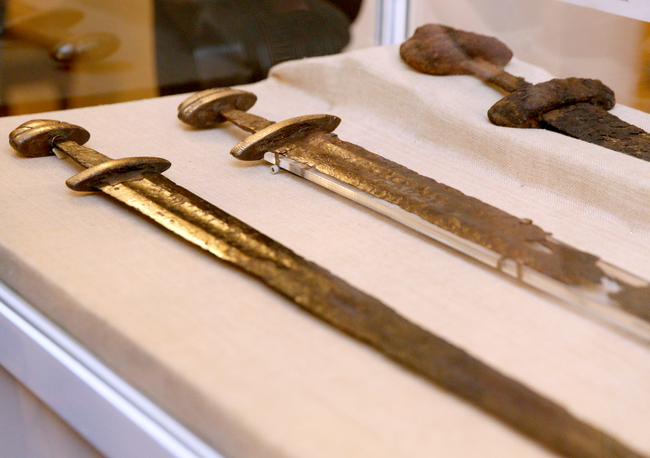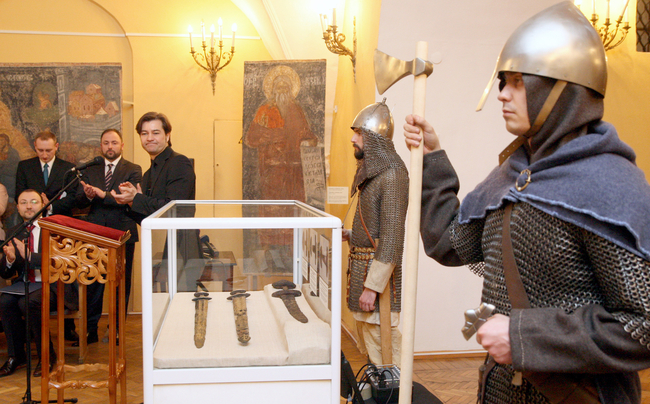In late January, Security Service of Ukraine (SBU) operatives in Rivne oblast busted, in fact for the first time in the history of Ukraine, an international ring of smugglers who handled stolen antiquities.
Past year a 10th-century sword was returned to Ukraine before being smuggled to the European Union – the crime was prevented by Estonian guards on the border with Russia. At first the intention was to give the artifact to Russia, but, following a stir caused by Ukrainian representatives, the so-called “Viking sword” was returned to where it had been found. It is also a unique situation. Today’s market of illegal antiquities trade resembles a black hole – something huge, awful, and totally hard to grasp.
DIFFERENT DESTINIES OF SWORDS
Archeologist Maksym Levada, who drew public attention to the Viking sword situation, repeatedly wrote past year about illegal possession of other artifacts, but these materials received no publicity. He wrote in May 2016 in the article “Sword as a Symbol” (website “Museum Space”) about several Ancient Rus’ swords put up for online auctions. Among them are the artifacts found in Vinnytsia and Khmelnytskyi oblasts – no one knows what has happened to them.
It was possible to trace the route of a find Levada describes in the abovementioned material, although this did not lead to a successful end. In September 2013, a person nicknamed “diver” announced on the website “Violity” (we will get back to this later) that he had found an ancient sword. The 95.5-cm-long artifact weighing a kilogram was picked up from the Styr riverbed 10 kilometers from Lutsk.
Past June the administration of Lutsk’s State Historical and Cultural Preserve turned to Culture Minister Yevhen Nyshchuk about this sword. The statement, which Levada handed over to The Day, says about the rarity: “It is a unique museum-level archeological find in a very good condition. The sword in question looks very much like Sviatoslav’s sword found in 2011 in Khortytsia. It is therefore clear that this artifact is linked with an archeological site – a 10th-13th-century hill fort at the village of Zhydachyn that is mentioned in ancient chronicles.”
The preserve recalled the sword three years after the announcement because the artifact was unexpectedly seen at the exhibit “The Sword in the History of Ukraine” in the National Military Historical Museum of Ukraine. The exposition included objects from the private collection of Yevhen Hredunov. The preserve’s administration requested the Ministry of Culture to pass the sword information to investigative bodies so that they withdraw the rarity and tale legal action.

In late June 2016 the Ministry of Culture formally requested Interior Minister Arsen Avakov to verify the information the preserve had furnished.
On September 26 past year the Main Directorate of National Police in Kyiv oblast answered the query of the Lutsk preserve. The document Levada made available to The Day says: “It was impossible to question Ye.V. Hredunov in writing because he informed us that he has a large number of swords and he was not aware of what exactly sword we mean. He will give a detailed explanation in the answer to a written query. It also turned out impossible to establish a particular historical, scientific, artistic, and cultural value of the sword in question.”
They found no grounds for entering the data of this situation into the General Register of Pretrial Investigations. The police sent a request to the Cultural Heritage Preservation Directorate. The law-enforcers promised to resume examination after receiving the answer and if a breach of law is found. The Day has written to the National Police to inquire about how things are going.
Levada thinks the happy comeback of Viking sword was possible, above all, thanks to Estonian customs officers. What caused them to do so is their honesty. Also an important role in this situation was played by the reaction of society and some official bodies – for example, MP Dmytro Tymchuk demanded that the Prime Minister of Ukraine intervene in the situation, while Ukraine’s Ambassador to Estonia Viktor Kryzhanivskyi officially requested the Estonian authorities to restitute the seized sword. The Ministry of Culture and the SBU have also made proper efforts.
THE LAW IS ADEQUATE, BUT…
“This is practically the first time a case of the destruction of our cultural heritage was brought to conclusion. I can perhaps recall just one similar case, when some Bosporan coins were found in Westphalia, Germany, and German policemen and officials handed them over to us. We gave them to a Kerch museum, where they are still kept,” Hlib IVAKIN, deputy director of the Ukrainian National Academy of Sciences’ Institute of Archeology, reminisced as the SBU operatives who exposed the group of smugglers were being honored. “It is very difficult to bring such cases to conclusion, especially when lawyers participate. For example, people dig a mound and say: ‘We are digging not a mound but a well for ourselves.’ And these people are left free. We don’t like the expression ‘black archeologists.’ There are archeologists and there are plunderers. They are neither black nor blue, and I can feel they are being taken in hand at last.”
Incidentally, experts believe that the Ukrainian laws that regulate the circulation of rarities are quite acceptable. The problem is that they do not work.

“The law regulates everything, and it is more or less good. What we need is more active law-enforcement bodies. They should have enough money and staff to deal with these things, and everything will be OK,” says Viktor CHABAI, director of the Ukrainian National Academy of Sciences’ Institute of Archeology. “The Viking sword’s story is unique and really very good. But law-enforcement bodies obviously lack full-time specialists.”
WHERE RARITIES ARE “DUMPED”
It is difficult to imagine the scale of antiquity plunder. Chabai says bluntly: “You should open websites of the plunderers of archeological sites and see how many artifacts are there. These people hold congresses to boast of their finds. You can see this easily.” The Violity auction’s website is very often mentioned in this connection. Incidentally, Den/The Day published later past year an article by the well-known historian Fedir Androshchuk about an 11th-century decorative element found during an illegal excavation in Skvyra raion, Kyiv oblast (“Where the Wind Is Blowing?” in The Day’s No. 80, December 27, 2016). The bronze figure of a beast was sold at Violity and then auctioned off in Britain.
Levada once tried to count the number of artifacts. He used the Violity statistics for June 2013 – November 2014 (“War to Some, Boon to Others” in “Museum Space”). It is impossible to get fresher information because the auction’s server was relocated to the UK and statistics were zeroed from late 2014 onwards. Firstly, the data show that sales increased nine-fold (!) in 18 months. On the whole, 137,428 lots were placed at Violity. But the number of the items put up for auction is much larger because one lot may consist of several dozens of objects. “In these 18 months, much more archeological objects were sold through this auction alone than there are in the depositaries of the National Museum of Ukrainian History,” Levada concludes in his article.
“A TOTAL BAN CANNOT BE A MEANS OF CONTROL”
“Our law is not perfect, but, in my view, the problem is not in the law,” says Yurii SAVCHUK, a senior research associate at the Academy of Science’s Institute of History. “Even ideal laws do not work by themselves. We should change the mental approach and traditions. The current Ukrainian law provides more than enough instruments, but things are hampered by a somewhat tolerant attitude to this problem of the academic, cultural, and political elites. We know about the vogue to collect rarities among topmost officials, including presidents of Ukraine. It is a multifaceted problem.”
In Savchuk’s words, the domestic and foreign rarity sales markets are closely intertwined. Whoever commits this kind of crimes on the domestic market usually has some channels abroad.
“The inventory of collections and ‘black archeology’ are closely related matters. For example, the laws on the movement of cultural values and on museums are the fingers of one hand. A problem cannot be solved without a systemic approach,” Savchuk continues. “A total ban cannot be a means of control. What can help here is legalization and registration of collections, improvement of the law, registration of the non-state-owned part of Ukraine’s museum property, and forcing the owners of museum values to take social commitments. Things would look entirely different if we had a registered non-state-owned museum property, if collections were registered, and if it were clear in what way and when additional objects will appear on this market.”
The people who plunder artifacts are hardly aware of their material and, all the more so, historical value (items are often resold at foreign auctions at a much higher price than in Ukraine). “All the powers that be in the world – in the US, Russia, Ukraine, etc., – are mostly afraid of publicity. In the cases when antiquities are stolen, there should be as much publicity as possible. Even if it fails to produce a direct result, it will still make an impression on institutions, become known to experts, and remain useful,” Savchuk asserts.
It is undoubtedly important to record crimes. But it would be better if our descendants learned about our antiquities at museum expositions rather than from the chronicle of plunders.







